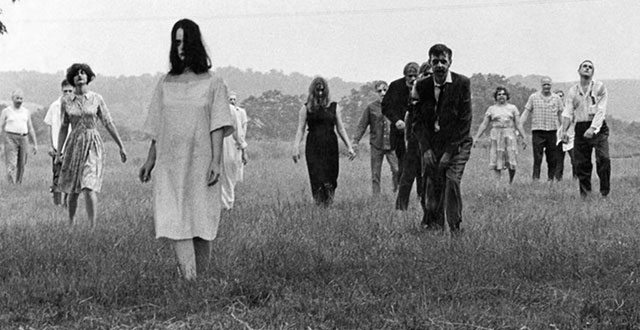
Guess What’s Back From the Grave? ‘Night of the Living Dead’
Glenn Kenny 10/27/2016When “Night of the Living Dead” opened in 1968, mostly in grindhouse theaters, Vincent Canby of The New York Times dismissed it in a three-sentence review as “a grainy little movie acted by what appear to be nonprofessional actors, who are besieged in a farmhouse by some other nonprofessional actors who stagger around, stiff-legged, pretending to be flesh-eating ghouls.” He said the filmmakers were “some people in Pittsburgh.”
As it happened, “Living Dead” followed a trajectory rare in American film: Partly fueled by other, more scandalized reviews (including one by a young Roger Ebert, in Reader’s Digest), it went on to cult success, and two years later was recognized as being sufficiently artful to be placed in the permanent collection of the Museum of Modern Art. Its influence, particularly on the now nearly ubiquitous subgenre of zombie horror (“The Walking Dead” on TV, and the movies “28 Days Later,” “World War Z” and “Shaun of the Dead”) is broadly recognized.
But the filmmakers themselves — the “people from Pittsburgh” who formed a company they called Image Ten to make the low-budget movie — have been able to gain from their groundbreaking work only in a limited way. The film’s original distributor, the Walter Reade Organization (named for its founder, a pioneer of art-house distribution), did not file for a new copyright after changing the title from the original “Night of the Flesh Eaters” to “Night of the Living Dead.” That meant the movie went into the public domain almost immediately. As was once the case with Frank Capra’s “It’s a Wonderful Life,” the movie has been subjected to many unofficial, though legal, iterations.
The paradox of the situation has not been lost on its director, George A. Romero. “The fact that people were able to show it for free, that anybody was able to distribute it, did result in lots of people seeing it, and keeping the film alive,” he said in a phone interview. But viewers were too often watching inferior versions. That will change — dramatically, the moviemakers hope — on Saturday, Nov. 5, when the Museum of Modern Art screens a new, and copyrightable, restoration of “Living Dead” as part of its annual restoration and preservation festival, “To Save and Project.”

“We got our baby back,” Gary Streiner, one of the film’s producers, said in a phone interview.
The process, Mr. Streiner said, began in earnest last year, when he; his brother, Russ (who co-produced and also played Johnny in the movie); and the screenwriter John Russo resolved to make a proper inventory of the film’s surviving elements, going through their own archives and the archive of the lab that originally worked on the film.
They turned to MoMA for help, partly because of its history with the film and partly for a practical reason. “Our vaults are in Pennsylvania,” said Katie Trainor, the MoMA’s film collections manager. “Once they had the materials together, they did not want to risk shipping them; they drove them from Pittsburgh. They were literally looking over my shoulder as I was inspecting the materials.”
Mr. Streiner recalled his relief at finding the negative in decent shape: “We could have opened the cans and found dust!”
The restoration was backed by, among others, the Film Foundation, the preservation nonprofit started by the director Martin Scorsese. In an interview, its executive director, Margaret Bodde, said, “The movie had been on a wish list of ours for some time,” and it helped “that we had the director around to consult with, which is too rare in film restoration.”
Mr. Romero said that it had been years since he had seen the film presented in its proper aspect ratio, a squarelike 1.37 to 1; many versions had been cropped to wide-screen proportions. “The restoration is very beautiful, and of course the movie’s pimples do show,” he said. “There’s a copy of the script visible in one of the frames! I won’t tell where. It will be a little challenge for fans to spot it.”

As Ms. Trainor toiled with the filmmakers, she learned what a shoestring Image Ten had worked on. “The car in the opening scene belonged to the Streiners’ mother,” she said. “They borrowed it from her, and she didn’t realize they’d smashed the windshield because they replaced it before returning it to her. The dent they show in the car after it rolls into the tree was there to begin with, though.”
Josh Siegel, curator of film at MoMA, said in an interview, “It’s an unfortunate turn of historical fate that Image Ten created one of the most successful horror films of all time and didn’t reap the benefits of it.”
Over the years, members of the original filmmaking team have tried to mine some profit from their vision, creating alternate cuts, even a colorized version. Because restoration at a certain level has been deemed to create new intellectual property, this is the first time the film as they wanted it seen will, to an extent, belong to them.
Reflecting on what “Living Dead” spawned, Mr. Romero said: “They aren’t really zombie movies; ‘Night’ wasn’t really a zombie movie. I always understood zombies as living beings put under a kind of spell, as in ‘I Walked With a Zombie’ or ‘The Serpent and the Rainbow,’ that kind of thing. Our creatures, and the ones in movies such as ‘28 Days Later’ and ‘World War Z,’ are the dead returning to life.”
Now 76, Mr. Romero has mostly stayed in indie film, creating a big body of work, including five more film variations on the “Living Dead” theme. “I recently realized that I couldn’t get financing for an inexpensive zombie film anymore, because of Brad Pitt,” Mr. Romero said with a chuckle, referring to the actor and producer of “World War Z.” He added, “I’m hoping to get back into the playground, though.”
The New York Times